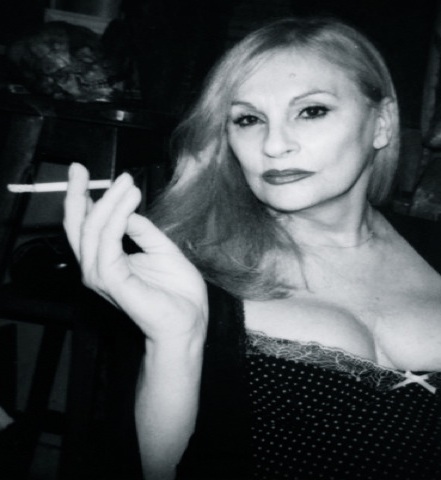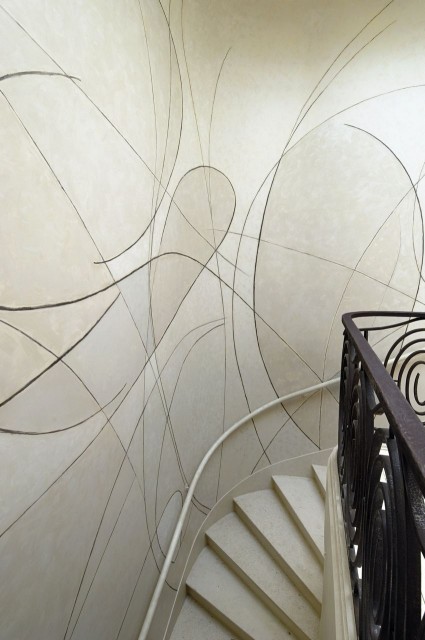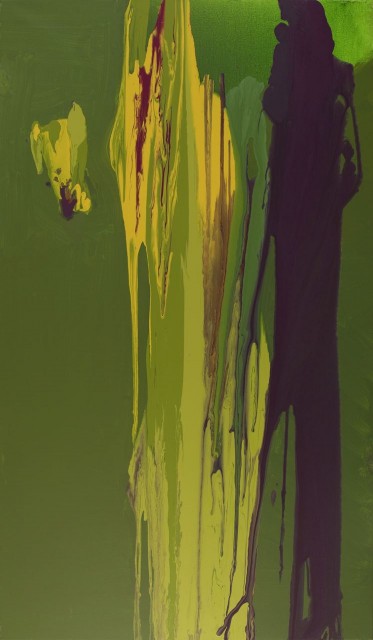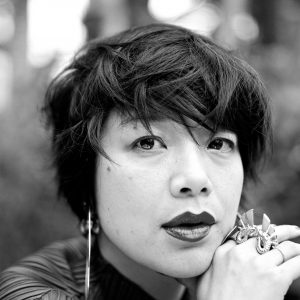Photo by © Charles Duprat
The History of Herstory
FLORENCE DERIVE is an artist and interior decorator. She frequently collaborates with architect Alberto Pinto. As with all other participants, Seymour sent Florence a standard interview questionnaire. What we got in return was a beautiful poem recounting her life story. Florence has always had the courage to listen to her true self above all others. Her creativity, art and life are unique and an immense source of inspiration. She is her own most beautiful creation.
Translated from French by Melissa Unger.
“Daydreamer, well-behaved, easygoing and happy.”
These words accurately describe my childhood. I was raised by my grandparents and as a result, largely defined by their two basic principles of education:
“Don’t get yourself or anything else dirty and a child should not stay cloistered indoors.”
Only one large room filled with closets and a tiny kitchen with its always-cluttered table; undoubtedly explain the root of their two principles.
In return for acquiescing, at each holiday I was afforded an outing with my grandmother and on Sundays, a family outing. Sunny days saw us in one of the verdant parks or wandering along the port of Nantes. Rain swept us into the department stores, the Museum of Natural History or Fine Art; sheltered places filled with warmth and wonders.
Grandmother Rose always stayed a step behind, holding, in wintertime, my coat, slung over her arm. Smiling, she’d say: “Look closely, Johnny!’ and I would. I was curious about everything: hatpins, hammerhead sharks, hummingbirds, 18th century women painted in their housecoats, Christmas windows, cars, signs, posters, passersby and the boats at quayside.
On grassy greens, she’d bend over and lay out a square of fabric.
“We’ll be comfortable here!” she’d exclaim.
Knitting quietly, she would glance over her glasses at me and smile. Daisies, dandelions, twigs and insects: an entire little world hidden within the grass. So much to see, so many stories to imagine, so many afternoons gloriously melted away.
Languid by nature, in the schoolyard I preferred girl talk to boy’s games.
“Sissy.” Hissed the boys.
Disconcerted by my unruffled acceptance of this appellation, they contended themselves with having put a name to a species hitherto unknown to them: the girly-boy.
And so began a long period of observation and the curation of an irreversible library of memories that would weave itself forever into my brain…
Professor Barré, a paedophobe, teacher of Latin and French, notices an effeminate 10 year-old boy: his student Derive, and quickly relegates him to the back of the class, sending his grades into a freefall in the process.
The loyal friendship that his favorite girls afforded me, only served to aggravate my teacher’s visceral and uncontrolled hate. Apart from Jeanine Coton, best in the class and my best friend, no one around me understood why I was suddenly a ‘very bad boy’ who had become a dunce. Punishments were doubled, chastised both at school and at home, only the short trip that separated the two provided respite.
At that time there was no communication between teachers and parents, so no doubts were raised about my possible mistreatment at the hands of a professor: I had only myself, my own laziness and my own stupidity to blame.
But in the end, it was he who was the first one to understand who I was. I didn’t even know it yet myself. His hate pursued me for many years until I was finally expelled. At the start of a new school year he had cornered me in the hallway and said: “So, you made it to 8th Grade? Don’t count on making it to 9th.” My fear of him was such that I learned no lessons, did no homework that entire year…I fell ill and was at long last expelled…
Thankfully, the Arts and Muses rush to my aid!!
A new school, where my eccentricities pleased everyone (or almost) and where I was transformed, thanks to good professors, into a good student!
I rediscovered my childhood love of Fine Art. For the few who were interested, the Argos Gallery in Nantes, exhibited 20th Century masters. It was there that I first saw Vasarely, Morellet (who was doing Op Art at the time ) and Paris’ abstract painters. A stash of small art books enabled me to discover Mondrian, Paul Klee and Max Ernst. I enrolled in the free classes available at L’école des beaux-arts de Nantes.
Afterschool, I would color the dry earth of an old slate quarry with smashed up ‘borrowed’ chalk sticks. André was my helper and ‘number one fan.’ As a finishing touch to my brightly hued work, I would pour fluorescein into a deep, vast water hole. We’d climb up a tree to better contemplate ‘Tomb For A Crushed Mole’ in its glorious entirety.
The spring of my fifteenth year took place on this rain-faded carpet of colors. André encouraged all my wildest fantasies. Color and an art lover: Nothing better!
Adolescence, youth, college…and…
How does one manage to gain enough distance to view one’s self objectively? To detach from our construction of self, a self set in motion during gestation and underlined during childhood through the ‘education’ one receives. Not to mention the volume of weighty influences linked to the social environment of our era.
I did the best I could…
To be aware of one’s self at least in part, is hard enough, to see one’s whole self might be too painful.
But one can manage to reach one’s truth, particularly if one has a motive compelling enough to try.
A handicap, a difference that marginalizes; whatever issues position themselves as barriers to a fulfilling life. I was going to say ‘happy’, but happiness is too volatile an element to be a constant companion of our existence. It sometimes visits us…that’s already considerable.
What came out of all this introspection, first and foremost, was that my professor had been correct: I was a girl; on the inside since always, and now I would have to be on the outside too.
There was never a divisive rupture, but rather a slow conciliation of these two selves. And perhaps my greatest stroke of luck was to be able to work in a creative, artistic environment, one that tolerated everything, except perhaps… bad taste.
1977- Hello Florence
1978- Hello Alberto Pinto
1995- Hello love and painting…forever and always. (I am speaking of the painting of course.)
1978- Navy blue suit, flats and a string of pearls, I join Alberto Pinto’s team with a solid portfolio. Toward the end of the 1980’s he asks me to create a series of modern and contemporary murals for a variety of sumptuous architectural projects around the world. He allows me to do what I love most: paint. Decorative painters must know how to juggle a number of factors: the decorator’s vision, the client’s wishes, time limits, budget limits, a pre-defined space, furniture, geographic location and still be able show a talent for new ideas…Although: “Nothing is as old as the new!”- Jacques Prévert.
One must not splash one’s deepest self on the client’s wall! One doesn’t approach a businessman’s home/office in London in the same way as a sun-filled family room on the edge of the Mediterranean…The painter must have culture, imagination, fantasy and taste…(tall order!) And also, to be good with clients, be punctual…Yes, M’am!
Interior wall-mural by Florence Derive. Private client London.
Our current society separates Fine Art from Decorative Art despite the fact that it produces Fine Art in semi-industrial quantities. Increasingly lost in a desire to seduce at all costs, the product often lacks any new ideas. Is this perhaps the reason that beauty and emotion seem to be increasingly rare? We have become wild for meaning, so much so that discourse even precedes the artist and his work…we tell their stories before they have even had a chance to live them.
“Why I resist interviews; they foreground the artist. Tell too much about what wouldn’t be known when confronting the work.”-Louise Lawler (in 1947)
 Florence in her studio.
Florence in her studio.
1995 – Ready to paint!
But first I must tell you a bit more about my childhood for its within it that I found the visual vocabulary that allowed me to express myself and to express the discordance, the fundamental imbalance upon which my adult emotional life was ultimately constructed.
Despite being an accomplished acrobat and juggler, my psychic flexibility has its limits…and the practice of art provided a much-needed solid footing. Creativity is such a grand companion, it transports you and helps you to forget your most constant and loyal follower: loneliness.
From the ‘memory library’ of my younger days will surge forms, colors, music, scents, and also lights from the ever-changing skies and the bustling city.
One must capture emotion; materialize the mood of each day by dipping into one’s great reservoir of memory and choosing the necessary elements to accomplish this materialization.
Through the manual labor of the application of color, whether by small, delicate strokes or wide swatches, an internal logic begins to appear in my paintings and guides me as to where to place forms and colors.
To lean in close or to step back to consider it from a distance, to evaluate the work and to eventually deem it done. To relish in the jubilant satisfaction of seeing before one’s eyes a representative image of one’s own soul; an image that ‘wanted’ to appear.
Shadow by Florence Derive. 195 cm x 95 cm
The act of painting is an act of liberation, of creation and gives life to an image that when observed reminds the viewer of something equivalent buried deep within himself.
-Florence Derive 2011
To view more of Florence’s work, please visit: www.florence-derive.fr
Published: October 28th, 2011








